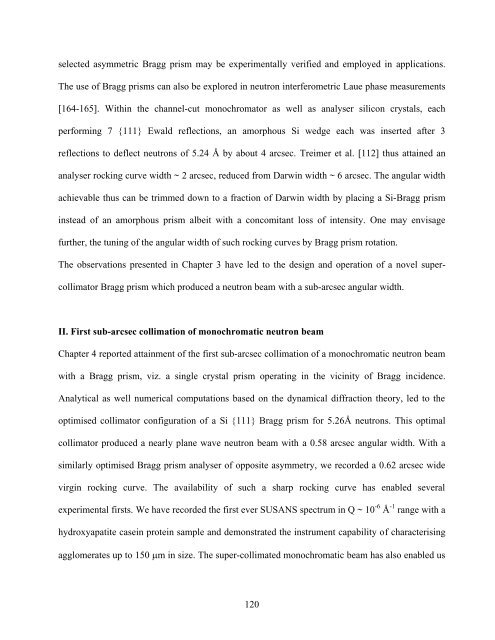PHYS01200804001 Sohrab Abbas - Homi Bhabha National Institute
PHYS01200804001 Sohrab Abbas - Homi Bhabha National Institute
PHYS01200804001 Sohrab Abbas - Homi Bhabha National Institute
Create successful ePaper yourself
Turn your PDF publications into a flip-book with our unique Google optimized e-Paper software.
selected asymmetric Bragg prism may be experimentally verified and employed in applications.<br />
The use of Bragg prisms can also be explored in neutron interferometric Laue phase measurements<br />
[164-165]. Within the channel-cut monochromator as well as analyser silicon crystals, each<br />
performing 7 {111} Ewald reflections, an amorphous Si wedge each was inserted after 3<br />
reflections to deflect neutrons of 5.24 Å by about 4 arcsec. Treimer et al. [112] thus attained an<br />
analyser rocking curve width ~ 2 arcsec, reduced from Darwin width ~ 6 arcsec. The angular width<br />
achievable thus can be trimmed down to a fraction of Darwin width by placing a Si-Bragg prism<br />
instead of an amorphous prism albeit with a concomitant loss of intensity. One may envisage<br />
further, the tuning of the angular width of such rocking curves by Bragg prism rotation.<br />
The observations presented in Chapter 3 have led to the design and operation of a novel supercollimator<br />
Bragg prism which produced a neutron beam with a sub-arcsec angular width.<br />
II. First sub-arcsec collimation of monochromatic neutron beam<br />
Chapter 4 reported attainment of the first sub-arcsec collimation of a monochromatic neutron beam<br />
with a Bragg prism, viz. a single crystal prism operating in the vicinity of Bragg incidence.<br />
Analytical as well numerical computations based on the dynamical diffraction theory, led to the<br />
optimised collimator configuration of a Si {111} Bragg prism for 5.26Å neutrons. This optimal<br />
collimator produced a nearly plane wave neutron beam with a 0.58 arcsec angular width. With a<br />
similarly optimised Bragg prism analyser of opposite asymmetry, we recorded a 0.62 arcsec wide<br />
virgin rocking curve. The availability of such a sharp rocking curve has enabled several<br />
experimental firsts. We have recorded the first ever SUSANS spectrum in Q ~ 10 -6 Å -1 range with a<br />
hydroxyapatite casein protein sample and demonstrated the instrument capability of characterising<br />
agglomerates up to 150 m in size. The super-collimated monochromatic beam has also enabled us<br />
120
















